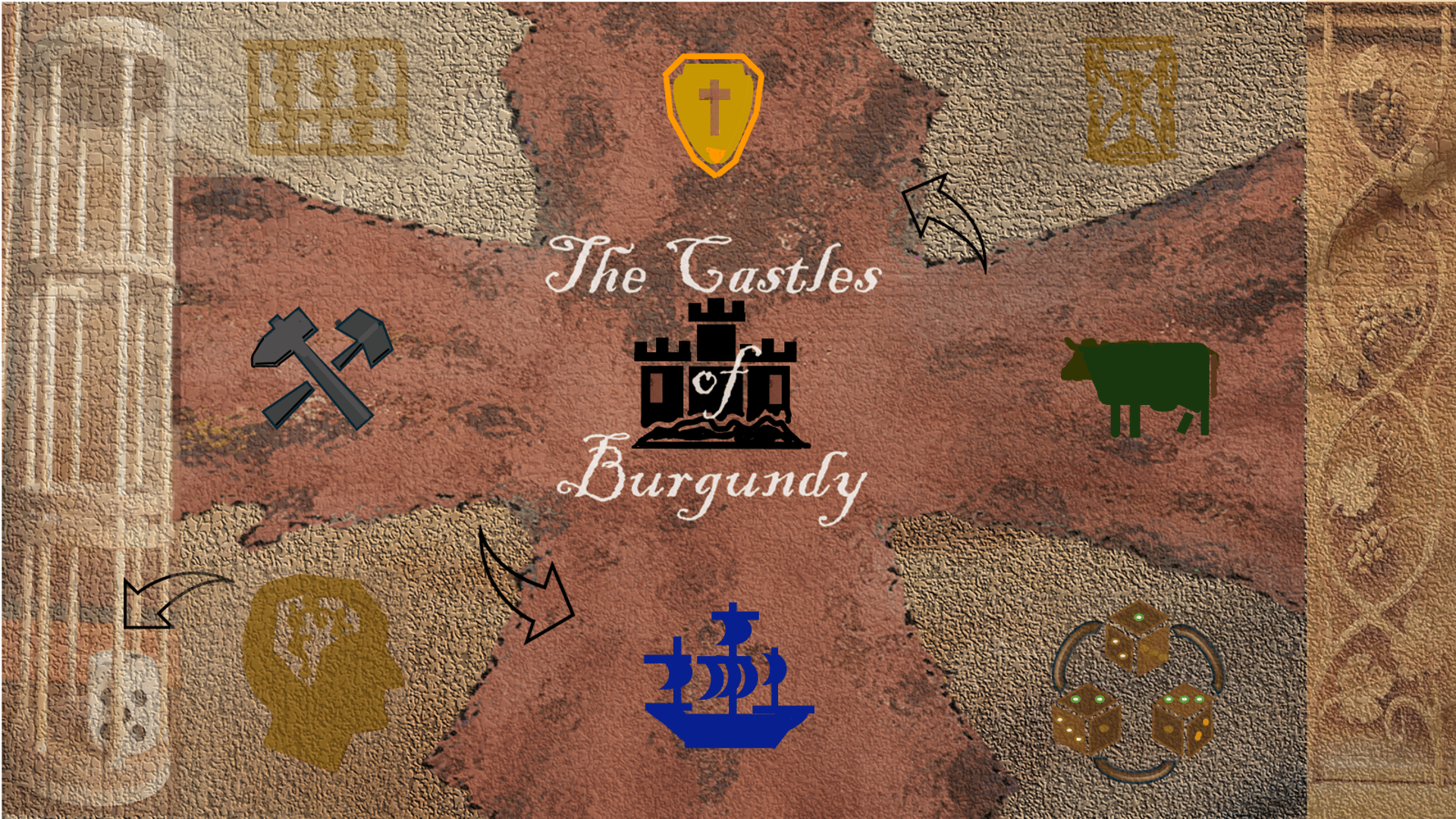The Quintessence of Comboing
A review of The Castles of Burgundy
Chris Sanderson

I must admit, when I first opened the box and saw those bland honeycombed player boards, my heart sank.
Not much, mind. Just an inch or two. But it was undeniable.
As I contemplated those boards, 'Medieval duchy' wasn't the first thing that sprang to mind. Join the dots, perhaps? Hexadotku? And what about that artificial segregation of fields and monasteries, castles and mines, clustered like Soviet-style communes? My hope of being carried away in a wistful escape to ages past all but disappeared down the plughole.
Still, we'd been gifted the game, so we might as well make the best of it, I reasoned.
I quickly got the gist. Buy buildings and mines and bits of river, then store them in a tripartite interdimensional zone before finally transferring them to some mad architect's Middle Age hexagonal dystopia.
It made sense.
Unless you weren't a mad medieval architect, in which case it didn't much.
As I got more familiar with the game, however, I made a surprising discovery.
Theme isn't everything.
Yes, The Castles of Burgundy has taught me that games don't need a believable theme; they need just a hint, an atmosphere suggestive of something beyond its boards and tiles and cards.
Is there a medieval feel to The Castles of Burgundy? Not really.
Does it matter? No.
Is the game dry, as many people say?
Hmm. Do you mean like dry wine, like dried fruits?
Like dry humour?
Okay, it's dry. I like dry. If 'dry' means not trying to be more than what it is, then dry is perfect.
I like that the game has nothing extraneous, nothing added or taken away. No frills. Everything fits, everything is justified, everything just ... works. Perfectly.
Like those deliciously sweet combos.
Ah, The Castles of Burgundy may be a dry wine, but there's certainly a sweetness in those combos! This game is simply the Quintessence of Comboing.
What IS it about comboing that is soooo satisfying? This game more than any other forever poses that question, tantalises me with it.
Comboing.
Say the word slowly.
Com - bo - ing.
The word probably didn't even exist before The Castles of Burgundy, and if it did, it shouldn't have.
Comboing.
It's something to do with that almost primeval fascination we have of doing things that trigger other things. That power of turning a trivial action into the cause of a greater consequence.
You see it in the toddler that can't resist pulling books off the shelf and seeing them crash to the floor.
Or the astronomer of old rejoicing in observing far-flung celestial bodies line up, with himself at the end of the line as the Great Line Completer.
Everything lines up, and we feel like we're at the centre of the universe.
Okay, so I'm exaggerating a bit. But you get the idea. Pressing buttons, triggering cascading effects - it's what makes a game like The Castles of Burgundy more than just another game. It elevates the player to the status of a GIORE (Grand Initiator Of Ripple Effects), imperiously dragging buildings and boats and sheep into play.
And that's where the dice come in.
Oh, didn't I mention the dice yet?
Well, maybe that's because I've always had a complicated relationship with dice, to be honest. So many traditional board games were permanently marred for me by the clattering randomness of dice. A major factor that drove me to play chess was its dice-lack. I almost shudder at those memories of shaking a dice cup far too long and willing that all-decisive six to come out.
The Castles of Burgundy has changed all that.
No longer is clattering Master Luck the ruling factor. Luck can now be mitigated, really.
I love the smug feeling I get from mitigating luck. In The Castles of Burgundy, the dice are there at the centre, but they willingly step aside and let me share their hegemony, allowing me to harness their effects. Dice are now tools, even coworkers, not agents of irrational, determining forces.
The Castles of Burgundy ennobles dice. It takes their cubic, dotted vapidity and turns it into something ... quantic. Dice are now the openings of universes, unlockers of treasure troves, masters of ...
Okay, I'm going way off track again. I'd better turn my attention finally to that bugbear of bugbears, the CQ of TCoB.
Yep, the Component Quality.
Unfortunately, however, I am not very well qualified to talk about the component quality of The Castles of Burgundy, simply because I don't notice it.
Or perhaps because I can't imagine it any different.
For me, the best game components are those that don't get in the way of the game. And The Castles of Burgundy's components are perfect at not getting in the way of the game. They are as downright plain as they should be. (No frills, remember?) Who wants a game that merely amounts to the sum of its components? I want a game that transcends its components.
The Castles of Burgundy is a game that transcends its components.
Some games use components to seduce; The Castles of Burgundy doesn't seduce. It convinces.
Well, it convinces me, anyway. Completely.
Especially when I'm winning.
Yeh, I guess I'd have to write another review about my experience of losing. I'd call it The Hassles of Burgundy. And I'd probably ask my wife to contribute to that one. She's got the best view of that from the far side of the table.
But that's another story.



Hi, I am Chris Sanderson, an Englishman living near Madrid, Spain. Please send me your comments by email, or in BoardGameGeek through the links at the end of each game review.
© 2025. All rights reserved.